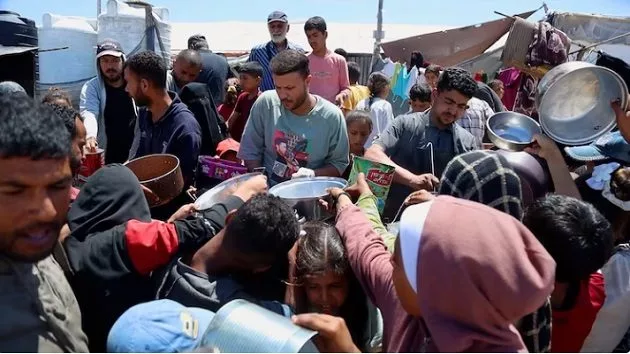
After more than two months without aid entering Gaza, raising the risk of famine for millions of people, some aid trucks have begun entering the territory in the past few days.
Israeli Prime Minister Benjamin Netanyahu announced some aid would resume entering the Gaza Strip Sunday, May 18. The Israeli government is working with the U.S. to set up aid distribution points. However, the plan faces criticism from established aid organizations. The Israeli-American system for distributing aid in Gaza is set to begin on Monday, according to two sources familiar with the matter.
Some local content creators in Gaza, who gained a following with their food and recipe videos, continued posting from food kitchens amid the shortage of aid — a way to keep hope alive and find joy as war rages on, they say.
“For me, this is passion, to cook delicious things in these difficult times, and I really started feeling like a useful person in this crisis and war,” Hamada Sho told ABC News. Sho is a popular content creator on social media who makes videos from Gaza, cooking and serving food to his community in Khan Yunis.
He began working with social media before the war, previously working in marketing and development with restaurants in Gaza. After deciding to help people during the ongoing war by cooking, he started to post videos showing his cooking process in March 2024, sharing them on social media for people beyond Gaza to see what life there is like.
One of the videos before the blockade, posted online in February, shows Sho making a dessert with fresh fruit and cream over a base of Twinkies and then delivering the treats to children gathered on the beach as he is greeted with loud cheers.
After Israel implemented a total aid blockade on Gaza on March 2, ingredients entering Gaza also halted. Because of the lack of supplies entering the Strip, the supplies that are inside have skyrocketed in price.
“Now I can’t cook larger quantities. I can barely purchase some from the market with these unbelievable prices.” Sho said. “Whether it was rice, beans or anything, the most important thing is that people have at least one meal a day.”
The Israeli government has said the aid blockade was meant to put pressure on Hamas to release the remaining Israeli hostages still being held in Gaza since the Oct. 7, 2023, Hamas-led attack on Israel, in which Hamas fighters killed 1,200 people and kidnapped 251 hostages. There are still 58 hostages held captive by Hamas, 20 of whom are presumed to be alive. The war has taken a large toll on Palestinians, with over 53,000 killed in Gaza since the conflict began, according to the Hamas-run Gaza Health Ministry.
The blockade, which began on March 2, started a day after a temporary six-week ceasefire between Hamas and Israel ended on March 1. Israeli forces resumed military operations in Gaza on March 18.
Sho works with local organizations, like Watermelon Relief, a grass-roots initiative in Gaza providing aid to displaced families, to get raw materials, which he uses to cook and provide food to refugee camps and communities in need of food, generally cooking from community kitchens.
Ahmed El-Madhoun, a coordinator for Watermelon Relief, explained that the raw food used in many of the videos posted by Sho was sourced from humanitarian aid entering the strip and traders located in Gaza.
“After Ramadan, things got worse. The border closed tighter, and food became harder and harder to find. Basic things like flour, cooking oil and even clean water,” El-Madhoun said.
Watermelon Relief had to close its kitchen due to the lack of cooking material, he added.
“No vegetables, no meat, nothing in the market. And if it’s available, it’s very expensive,” El-Madhoun told ABC News.
The Integrated Food Security Phase Classification (IPC), a system used around the world to track food insecurity and malnutrition, released an updated report on May 12, classifying the entire Gaza Strip as Phase 4, indicating that “the entire population is expected to face crisis or worse acute food insecurity.”
Twenty-two percent of Gaza will likely experience a food “catastrophe” according to the Integrated Food Security Phase Classification (IPC) report.
“Our team members inside Gaza are surviving on the cheapest staples they can find—lentils, fava beans, dry chickpeas—if anything is available at all. A single sack of flour, once a basic item, now sells for up to 1,700 shekels, or nearly $480. These last supplies will not last much longer,” Mercy Corps, a humanitarian aid organization, wrote in a statement regarding the IPC report. “The people of Gaza are enduring one of the most harrowing humanitarian crises in recent history.”
As food continues to be hard to access for many in Gaza, people have begun to rely on kitchens started by organizations that can make large quantities of food and serve it to the community.
“Everyone relies on community kitchens for their food now,” said Mohammed Abu Rijela, another content creator posting videos of cooking food in Gaza.
He was a content creator before the war. After being displaced at the beginning of the war, he decided to help his community by starting community kitchens in Gaza, producing over 10,000 meals a day.
Since the blockade, the number of meals Abu Rijela was able to produce has decreased significantly.
“Instead of making 10,000 meals a day, now I make 3,000. At the same time, people’s demand increased greatly in the kitchen,” he added.
Sho’s and Abu Rijela’s viral food videos were met with backlash on social media, with commenters denying the reality of the food crisis, citing the large amounts of food in the videos as evidence of the contrary. A post Sho made in March 2025, showing him cooking a chicken shawarma, became a focus of the online backlash.
El-Madhoun, with Watermelon Relief, told ABC News that most of the videos featuring meat were likely filmed months ago.
“We have not been able to find any meat for two months,” El-Madhoun said. Some traders were able to keep some meat in their warehouses, but due to the lack of electricity, storing the meat was not possible, he added.
Sho said many of the kitchens have shut down due to the lack of food, adding he has been cooking mostly legumes, peas, beans and rice during this time of low availability. Even these ingredients are sometimes unavailable, he said.
“The prices of very basic goods are skyrocketing. And the children, 1.1 million children, are suffering from that. They don’t have enough food,” a UNICEF spokesperson in Gaza told ABC News.
A UNRWA senior communications officer and spokesperson, speaking in Geneva on May 20, described the slow arrival of aid as: “Not enough. Five trucks, nowhere near. Not enough.” The comment came as humanitarian agencies have received permission from Israel for “around 100” more aid trucks to enter the Strip, five of which were let in on Monday.
In a press release on May 12, the World Health Organization (WHO) called the situation in Gaza “one of the world’s worst hunger crises, unfolding in real time.”
“We do not need to wait for a declaration of famine in Gaza to know that people are already starving, sick, and dying, while food and medicines are minutes away across the border,” said WHO Director-General Dr. Tedros Adhanom Ghebreyesus.
Copyright © 2025, ABC Audio. All rights reserved.



